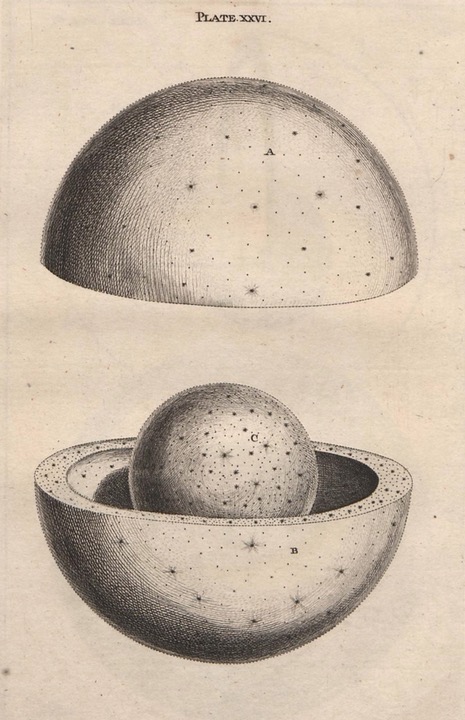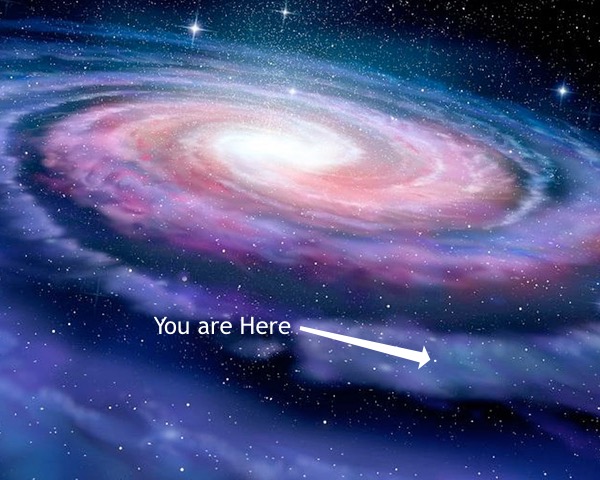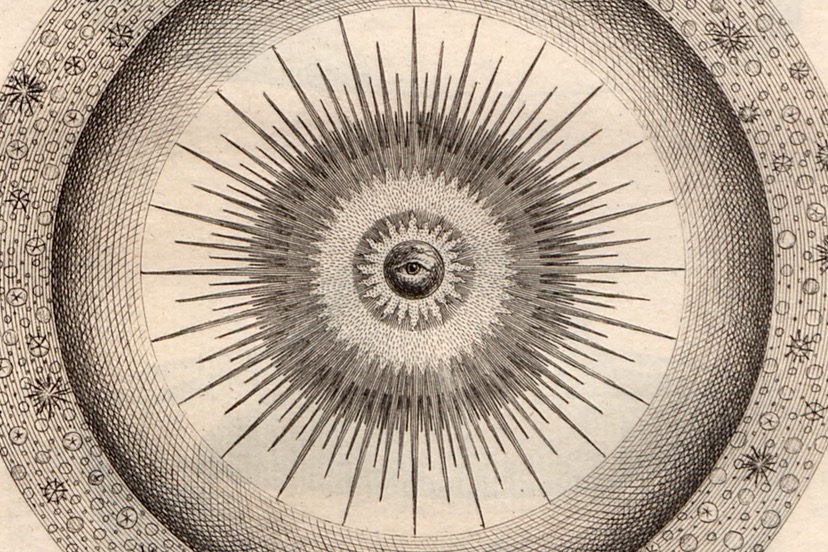Illustration from the book ‘An Original Theory or New Hypothesis of the Universe, Founded upon the Laws of Nature, and Solving by Mathematical Principles the General Phaenomena of the Visible Creation, and Particularly the Via Lactea’ by astronomer Thomas Wright, published in 1750.
I had never heard of English astronomer Thomas Wright until I came across an illustrated article about his theories, written by Maria Popova for her TheMarginalian.org website.
Apparently, Ms. Popova writes regularly about whatever seems worth writing about. Thomas Wright was worth writing about because he was the first published astronomer to suggest, in 1750, that the Milky Way was in fact a spiral galaxy, and that it was surrounded by other, more distant, galaxies.
This was a rather bold claim, because those other galaxies were not clearly identified until 1924, when astronomer Edwin Hubble calculated the distance to the Andromeda Galaxy, and realized that it was located outside the Milky Way galaxy.
We can imagine Hubble’s surprise.
I would have been just as surprised, if I’d done those calculations in 1924. But nowadays, we don’t have to do the calculations, because we have iPhones and we can simply ask Siri to look up the facts.
Unfortunately for Thomas Wright, Edwin Hubble’s calculations (and the iPhones) came too late to validate his theories. So he suffered the rejection of his theories by practically everyone who called themselves scientists, and he died in 1786, unappreciated, survived by his illegitimate daughter.
I don’t have an illegitimate daughter, but I am also unappreciated by people who call themselves scientists. I do, however, have my own hypothesis about the universe.
Back in 1750, when Thomas Wright was writing his book and commissioning elegant etchings to illustrate his theories, he was deeply religious, and surmised that God lived at the Center of the Universe. The Universe was constructed (he thought) sort of like Russian nesting dolls, with a larger sphere enclosing each smaller sphere…

…so the farther you went from the center, the bigger the universe became, but also the less perfect it became. (Being farther from God.)
This was a sensible hypothesis, in my humble opinion. Normally, when something gets bigger — like your waistline, for example, or the federal government — the imperfections become more obvious. And more serious.
That’s not the case, however, with Russian nesting dolls. They normally get more perfect as they get larger.
Russian nesting dolls were not invented until 1890, so Thomas Wright had no way to know about the larger dolls being more perfect.

Of course, not everyone nowadays is in agreement that the larger Russian dolls are more perfect. But that’s an argument for another day.
Meanwhile, most of the folks who care about astronomy (mostly, scientists) are in complete agreement that the planet Earth is not the center of the universe, and that in fact, our whole solar system is simply one of billions of similar solar systems, and that we’re situated in a outlying district of our galaxy.
Sort of like, in the ‘Aspen Springs’ of the Milky Way galaxy.

The main problem with the current theory, as I see it, is figuring out where God lives. Because obviously, that place would be the Center of the Universe.
That’s an assumption on my part, of course. Or I should say, it’s part of my hypothesis.
After the scientists like Hubble got a hold of the universe, it got a great deal bigger. Infinitely bigger. There were galaxies even larger than the Milky Way, as far as the eye could see.
Then they invented digital telescopes, and put them into orbit around the sun, where they wouldn’t be bothered by clouds and air pollution and whatever else might hinder the view from an earth-bound telescope. They found stuff even beyond the galaxies.
But amazingly, they can’t seem to find the Center of the Universe.
My theory is, they have been looking in all the wrong places. But also, in all the right places.
It’s pretty clear, if you read the Bible carefully, that Jesus didn’t have a home. But he wasn’t exactly homeless, like the homeless people in Seattle. He just really liked walking all around, meeting new people and doing miracles. Never staying too long in one place.
Like father, like son. The acorn doesn’t fall far from the tree.
That’s my hypothesis. God the Father is also footloose and fancy free. Doesn’t overstay His welcome; always off on another adventure. Meeting new people and doing miracles.
The astronomers can’t find the Center of the Universe, because it’s never in the same place twice.
Underrated writer Louis Cannon grew up in the vast American West, although his ex-wife, given the slightest opportunity, will deny that he ever grew up at all. You can read more stories on his Substack account.

